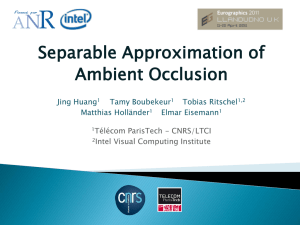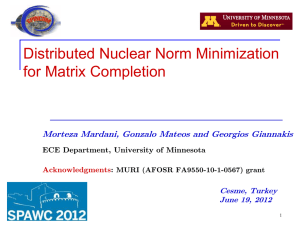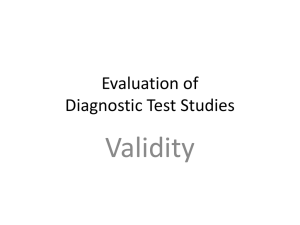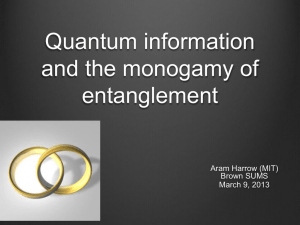The Separability Problem
advertisement
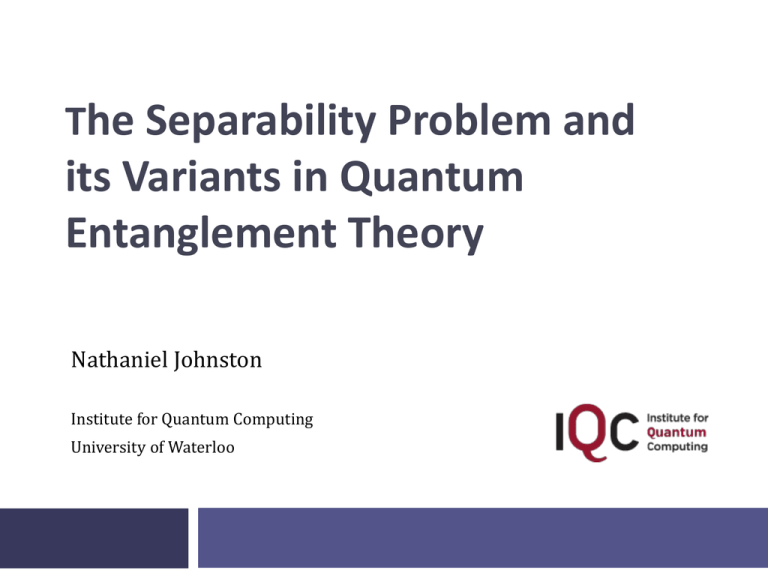
The Separability Problem and its Variants in Quantum Entanglement Theory Nathaniel Johnston Institute for Quantum Computing University of Waterloo Overview • What is Quantum Entanglement? • The Separability Problem • The Bound Entanglement Problem • The Separability from Spectrum Problem Overview • What is Quantum Entanglement? • Weird physical phenomenon • Linear algebra works! • The Separability Problem • The Bound Entanglement Problem • The Separability from Spectrum Problem What is Quantum Entanglement? Physicist Mathematician • Particles can be “linked” • • Always get correlated measurement results Tensor product of finitedimensional vector spaces • Tensors of rank > 1 exist That’s weird! • That’s obvious! • What is Quantum Entanglement? Pure quantum state: i.e., with Dual (row) vector: Inner product: with What is Quantum Entanglement? Tensor product: = = What is Quantum Entanglement? Outer product tensor product: Obtained via “stacking columns”: What is Quantum Entanglement? Definition A pure state is separable if it can be written as Otherwise, it is entangled. rank 1 rank 2 (thus entangled) What is Quantum Entanglement? Mixed quantum state: • Trace 1 • Positive semidefinite equivalent Pure state (again): • Rank 1 • Trace 1 • Positive semidefinite equivalent What is Quantum Entanglement? Definition A mixed state with each is separable if it can be written as separable. Otherwise, it is entangled. for some Equivalent: convex combination separable positive semidefinite is the “maximally mixed” state. Overview • What is Quantum Entanglement? • The Separability Problem • How to determine separability? • Positive matrix-valued maps • Funky matrix norms • The Bound Entanglement Problem • The Separability from Spectrum Problem The Separability Problem Recall: is separable if we can write for some Definition Given the separability problem is the problem of determining whether ρ is separable or entangled. This is an a hard NP-hard problem! problem! (Gurvits, 2003) The Separability Problem Separable states ρ All states The Separability Problem Method 1: “Partial” transpose Define a linear map Γ on In matrices: by The Separability Problem Apply Γ to a separable state: is positive semidefinite We say that ρ has positive partial transpose (PPT). Not true for some entangled states: which has eigenvalues 1, 1, 1, and -1. The Separability Problem Separable states PPT states ρ All states The Separability Problem Theorem (Størmer, 1963; Woronowicz, 1976; Peres, 1996) Let be a quantum state. If ρ is separable then Furthermore, the converse holds if and only if mn ≤ 6. • Separability problem is completely solved when mn ≤ 6 • Higher dimensions? The Separability Problem Method 1.1: Positive maps Given , define a linear map by In matrices: on The Separability Problem Definition is positive if whenever Transpose map: positive semidefinite Theorem (Horodecki3, 1996) A quantum state for all positive maps is separable if and only if The Separability Problem Separable states Transpose map ρ All states The Separability Problem The problem: • Coming up with positive maps is hard! • Proving that a map is positive is NP-hard Current status: • Dozens of papers • Only a handful of known positive maps The Separability Problem Method 2: Norms Definition The operator norm and trace norm of a matrix are defined by: where • • are the singular values of X. The Separability Problem Separable states ≈ unit ball of All states ≈ unit ball of The Separability Problem Definition Given define the S(1)-norm via Separable version of dual dual Separable version of The Separability Problem Theorem (Rudolph, 2000) Let be the dual of the S(1)-norm, defined by A quantum state ρ is separable if and only if The Separability Problem Separable states ≈ unit ball of All states ≈ unit ball of The Separability Problem The goal: derive bounds for • “Swap” operator: • “Realignment” map: because = 1 if ρ separable The Separability Problem Theorem (Chen–Wu, 2003) If then ρ is entangled. The goal: • Come up with more bounds on • Lower bounds entanglement • Upper bounds separability σ ρ Overview • What is Quantum Entanglement? • The Separability Problem • The Bound Entanglement Problem • • Not all entanglement is “useful” • Partial transpose is awesome The Separability from Spectrum Problem Bound Entanglement Can we turn mixed entanglement into pure entanglement? ρ ρ ρ Bound Entanglement Not always! Theorem (Horodecki3, 1998) If the quantum state has positive partial transpose then it is bound entangled (i.e., many copies of ρ can not be locally converted into an entangled pure state). Question: Are there more? Or is this “iff”? Bound Entanglement Separable states PPT states = Bound entangled states All states Bound Entanglement Let’s phrase the problem mathematically! • Recall: for we have • Similarly, • “Rank 1” and “full rank” versions of same norm Bound Entanglement We now want the “rank 2” version of this norm: Also need the “maximally entangled state”: standard basis of Bound Entanglement Theorem Define a family of projections P1, P2, … recursively as follows: Then there exists non-positive partial transpose bound entanglement (more or less) if and only if up to minor technical details (e.g., n ≥ 4 only) Bound Entanglement What do we know so far? • n = 4, k = 2: • • • • • • Big gap! equality when k = 1 • Overview • What is Quantum Entanglement? • The Separability Problem • The Bound Entanglement Problem • The Separability from Spectrum Problem • We only know eigenvalues • Want to determine separable/entangled Separability from Spectrum • Only given eigenvalues of ρ • Can we prove ρ is entangled/separable? Prove entangled? No: diagonal separable arbitrary eigenvalues, but always separable Separability from Spectrum • Only given eigenvalues of ρ • Can we prove ρ is entangled/separable? Prove separable? Sometimes: If all eigenvalues are equal then a separable decomposition Separability from Spectrum Can also prove separability if ρ is close to Theorem (Gurvits–Barnum, 2002) Let be a mixed state. If then ρ is separable, where is the Frobenius norm. Frobenius norm: eigenvalues of ρ Separability from Spectrum Gurvits–Barnum ball Separable states All states Separability from Spectrum Definition A quantum state is called separable from spectrum if all quantum states with the same eigenvalues as ρ are separable. States in the Gurvits–Barnum ball are separable from spectrum: But there are more! only depends on eigenvalues of ρ Separability from Spectrum Gurvits–Barnum ball Separable states Separable from spectrum All states Separability from Spectrum The case of two qubits (i.e., m = n = 2) was solved long ago: Theorem (Verstraete–Audenaert–Moor, 2001) A state is separable from spectrum if and only if What about higher-dimensional systems? eigenvalues, sorted so that λ1 ≥ λ2 ≥ λ3 ≥ λ4 ≥ 0 Separability from Spectrum Replace “separable” by “positive partial transpose”. Definition A quantum state is called positive partial transpose (PPT) from spectrum if all quantum states with the same eigenvalues as ρ are PPT. Separability from Spectrum Gurvits–Barnum ball Separable states Separable from spectrum All states PPT from spectrum Separability from Spectrum • PPT from spectrum is completely solved (but complicated) Theorem (Hildebrand, 2007) A state is PPT from spectrum if and only if • Recall: separability = PPT when m = 2, n ≤ 3 • Thus is separable from spectrum if and only if Separability from Spectrum Can PPT from spectrum tell us more about separability from spectrum? Yes! weird when n ≥ 4 obvious when n ≤ 3 Theorem (J., 2013) A state it is PPT from spectrum. is separable from spectrum if and only if Separability from Spectrum Gurvits–Barnum ball Separable states = Separable from spectrum All states PPT from spectrum Separability from Spectrum Sketch of proof. Write as a block matrix: ρ becomes “more positive” as B becomes small compared to A and C Lemma If then ρ is separable. Separability from Spectrum Want: every PPT from spectrum to satisfy hypotheses of Lemma. Not true! Lemma If then ρ is separable. Separability from Spectrum Instead: for every PPT from spectrum exists a 2×2 unitary matrix U such that satisfies hypotheses of Lemma. works for Lemma If then ρ is separable. there Separability from Spectrum Define Then some intermediate value of t works Lemma If then ρ is separable. Separability from Spectrum What about separability from spectrum for when m, n ≥ 3? Don’t know! Gurvits–Barnum ball Separable states Separable from spectrum All states PPT from spectrum Gurvits–Barnum ball Separable states PPT from spectrum = Separable from spectrum All states


